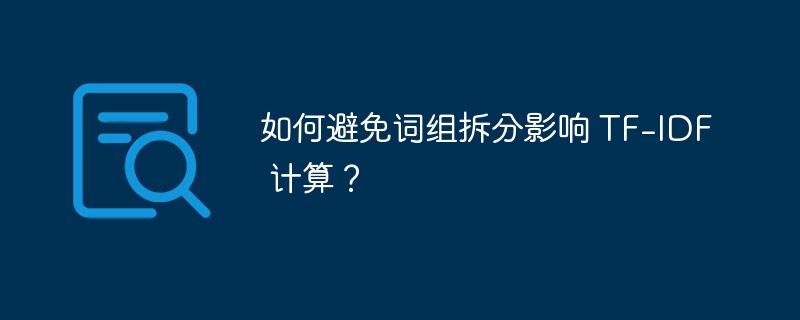如何避免词组拆分影响 TF-IDF 计算?
时间:2024-11-11 17:58:07 365浏览 收藏
一分耕耘,一分收获!既然都打开这篇《如何避免词组拆分影响 TF-IDF 计算? 》,就坚持看下去,学下去吧!本文主要会给大家讲到等等知识点,如果大家对本文有好的建议或者看到有不足之处,非常欢迎大家积极提出!在后续文章我会继续更新文章相关的内容,希望对大家都有所帮助!

自定义 tf-idf 计算,避免词组拆分
在使用 tfidfvectorizer 计算 tf-idf 值时,当文本数据包含词组时,可能会遇到自动分词的问题,导致输出特征包含分拆后的单词。为了解决这一问题,以下提供两种方法:
1. 调整 tfidfvectorizer 参数
如果文本数据中的词组由下划线或其他字符连接,可以设置 tfidfvectorizer 的 analyzer 参数为 "word",以禁用分词功能。
from sklearn.feature_extraction.text import tfidfvectorizer docs = ["this_is_book", "this_is_apple"] vectorizer = tfidfvectorizer(analyzer="word", stop_words="english") tfidf = vectorizer.fit_transform(docs) print(vectorizer.get_feature_names_out())
输出:
['this_is_apple', 'this_is_book']
2. 自定义 tf-idf 计算
如果你不想使用 tfidfvectorizer,也可以自行编写 tf-idf 计算程序。以下是一个示例实现:
import math
def tfidf_custom(docs, vocab):
"""
自定义 TF-IDF 计算
参数:
docs: 文档集合
vocab: 词汇表
"""
# 计算词频
tf_dict = {}
for doc in docs:
for word in doc:
if word in tf_dict.keys():
tf_dict[word] += 1
else:
tf_dict[word] = 1
# 计算文档频率
df_dict = {}
for word in vocab:
for doc in docs:
if word in doc:
if word in df_dict.keys():
df_dict[word] += 1
else:
df_dict[word] = 1
# 计算 TF-IDF 值
tfidf_dict = {}
for word in vocab:
tfidf_dict[word] = (tf_dict[word] / sum(tf_dict.values())) * math.log(len(docs) / df_dict[word])
return tfidf_dict
# 文档集合和词汇表
docs = ["This_is_book", "This_is_apple"]
vocab = ["This_is_apple", "This_is_book"]
tfidf_custom(docs, vocab)今天关于《如何避免词组拆分影响 TF-IDF 计算? 》的内容就介绍到这里了,是不是学起来一目了然!想要了解更多关于的内容请关注golang学习网公众号!
相关阅读
更多>
-
501 收藏
-
501 收藏
-
501 收藏
-
501 收藏
-
501 收藏
最新阅读
更多>
-
167 收藏
-
158 收藏
-
203 收藏
-
339 收藏
-
264 收藏
-
305 收藏
-
369 收藏
-
278 收藏
-
275 收藏
-
247 收藏
-
412 收藏
-
135 收藏
课程推荐
更多>
-

- 前端进阶之JavaScript设计模式
- 设计模式是开发人员在软件开发过程中面临一般问题时的解决方案,代表了最佳的实践。本课程的主打内容包括JS常见设计模式以及具体应用场景,打造一站式知识长龙服务,适合有JS基础的同学学习。
- 立即学习 543次学习
-

- GO语言核心编程课程
- 本课程采用真实案例,全面具体可落地,从理论到实践,一步一步将GO核心编程技术、编程思想、底层实现融会贯通,使学习者贴近时代脉搏,做IT互联网时代的弄潮儿。
- 立即学习 516次学习
-

- 简单聊聊mysql8与网络通信
- 如有问题加微信:Le-studyg;在课程中,我们将首先介绍MySQL8的新特性,包括性能优化、安全增强、新数据类型等,帮助学生快速熟悉MySQL8的最新功能。接着,我们将深入解析MySQL的网络通信机制,包括协议、连接管理、数据传输等,让
- 立即学习 500次学习
-

- JavaScript正则表达式基础与实战
- 在任何一门编程语言中,正则表达式,都是一项重要的知识,它提供了高效的字符串匹配与捕获机制,可以极大的简化程序设计。
- 立即学习 487次学习
-

- 从零制作响应式网站—Grid布局
- 本系列教程将展示从零制作一个假想的网络科技公司官网,分为导航,轮播,关于我们,成功案例,服务流程,团队介绍,数据部分,公司动态,底部信息等内容区块。网站整体采用CSSGrid布局,支持响应式,有流畅过渡和展现动画。
- 立即学习 485次学习
